Rear light Lancia Musa 2010 Owner handbook (in English)
[x] Cancel search | Manufacturer: LANCIA, Model Year: 2010, Model line: Musa, Model: Lancia Musa 2010Pages: 218, PDF Size: 3.71 MB
Page 181 of 218
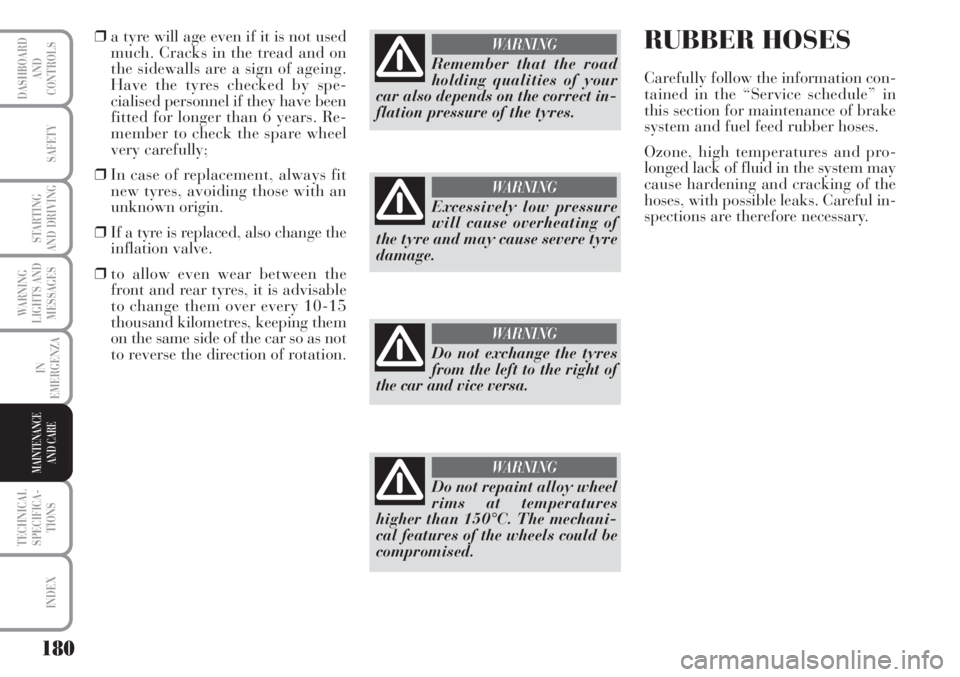
180
WARNING
LIGHTS AND
MESSAGES
TECHNICAL
SPECIFICA-
TIONS
INDEX
DASHBOARD
AND
CONTROLS
SAFETY
STARTING
AND DRIVING
IN
EMERGENZA
MAINTENANCE
AND CARE
❒a tyre will age even if it is not used
much. Cracks in the tread and on
the sidewalls are a sign of ageing.
Have the tyres checked by spe-
cialised personnel if they have been
fitted for longer than 6 years. Re-
member to check the spare wheel
very carefully;
❒In case of replacement, always fit
new tyres, avoiding those with an
unknown origin.
❒If a tyre is replaced, also change the
inflation valve.
❒to allow even wear between the
front and rear tyres, it is advisable
to change them over every 10-15
thousand kilometres, keeping them
on the same side of the car so as not
to reverse the direction of rotation.
Remember that the road
holding qualities of your
car also depends on the correct in-
flation pressure of the tyres.
WARNING
Excessively low pressure
will cause overheating of
the tyre and may cause severe tyre
damage.
WARNING
Do not exchange the tyres
from the left to the right of
the car and vice versa.
WARNING
Do not repaint alloy wheel
rims at temperatures
higher than 150°C. The mechani-
cal features of the wheels could be
compromised.
WARNING
RUBBER HOSES
Carefully follow the information con-
tained in the “Service schedule” in
this section for maintenance of brake
system and fuel feed rubber hoses.
Ozone, high temperatures and pro-
longed lack of fluid in the system may
cause hardening and cracking of the
hoses, with possible leaks. Careful in-
spections are therefore necessary.
Page 182 of 218
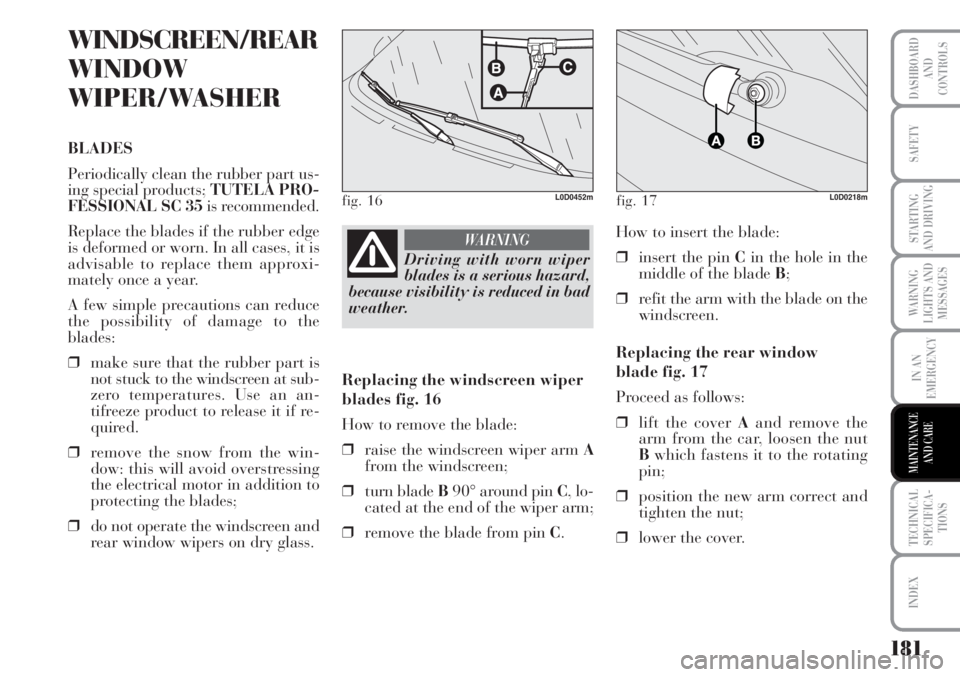
181
WARNING
LIGHTS AND
MESSAGES
TECHNICAL
SPECIFICA-
TIONS
INDEX
DASHBOARD
AND
CONTROLS
SAFETY
STARTING
AND DRIVING
IN AN
EMERGENCY
MAINTENANCE
AND CARE
WINDSCREEN/REAR
WINDOW
WIPER/WASHER
BLADES
Periodically clean the rubber part us-
ing special products; TUTELA PRO-
FESSIONAL SC 35is recommended.
Replace the blades if the rubber edge
is deformed or worn. In all cases, it is
advisable to replace them approxi-
mately once a year.
A few simple precautions can reduce
the possibility of damage to the
blades:
❒make sure that the rubber part is
not stuck to the windscreen at sub-
zero temperatures. Use an an-
tifreeze product to release it if re-
quired.
❒remove the snow from the win-
dow: this will avoid overstressing
the electrical motor in addition to
protecting the blades;
❒do not operate the windscreen and
rear window wipers on dry glass.
Driving with worn wiper
blades is a serious hazard,
because visibility is reduced in bad
weather.
WARNINGHow to insert the blade:
❒insert the pin Cin the hole in the
middle of the blade B;
❒refit the arm with the blade on the
windscreen.
Replacing the rear window
blade fig. 17
Proceed as follows:
❒lift the cover Aand remove the
arm from the car, loosen the nut
Bwhich fastens it to the rotating
pin;
❒position the new arm correct and
tighten the nut;
❒lower the cover.
fig. 16L0D0452mfig. 17L0D0218m
Replacing the windscreen wiper
blades fig. 16
How to remove the blade:
❒raise the windscreen wiper arm A
from the windscreen;
❒turn blade B90° around pin C, lo-
cated at the end of the wiper arm;
❒remove the blade from pin C.
Page 183 of 218
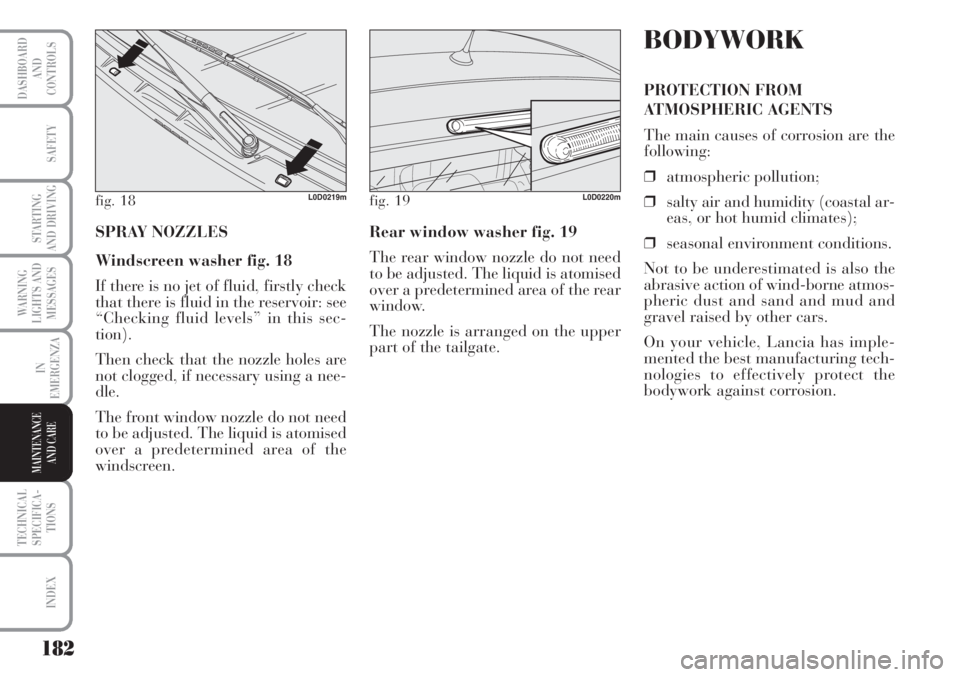
182
WARNING
LIGHTS AND
MESSAGES
TECHNICAL
SPECIFICA-
TIONS
INDEX
DASHBOARD
AND
CONTROLS
SAFETY
STARTING
AND DRIVING
IN
EMERGENZA
MAINTENANCE
AND CARE
SPRAY NOZZLES
Windscreen washer fig. 18
If there is no jet of fluid, firstly check
that there is fluid in the reservoir: see
“Checking fluid levels” in this sec-
tion).
Then check that the nozzle holes are
not clogged, if necessary using a nee-
dle.
The front window nozzle do not need
to be adjusted. The liquid is atomised
over a predetermined area of the
windscreen.Rear window washer fig. 19
The rear window nozzle do not need
to be adjusted. The liquid is atomised
over a predetermined area of the rear
window.
The nozzle is arranged on the upper
part of the tailgate.
BODYWORK
PROTECTION FROM
ATMOSPHERIC AGENTS
The main causes of corrosion are the
following:
❒atmospheric pollution;
❒salty air and humidity (coastal ar-
eas, or hot humid climates);
❒seasonal environment conditions.
Not to be underestimated is also the
abrasive action of wind-borne atmos-
pheric dust and sand and mud and
gravel raised by other cars.
On your vehicle, Lancia has imple-
mented the best manufacturing tech-
nologies to effectively protect the
bodywork against corrosion.
fig. 18L0D0219mfig. 19L0D0220m
Page 185 of 218
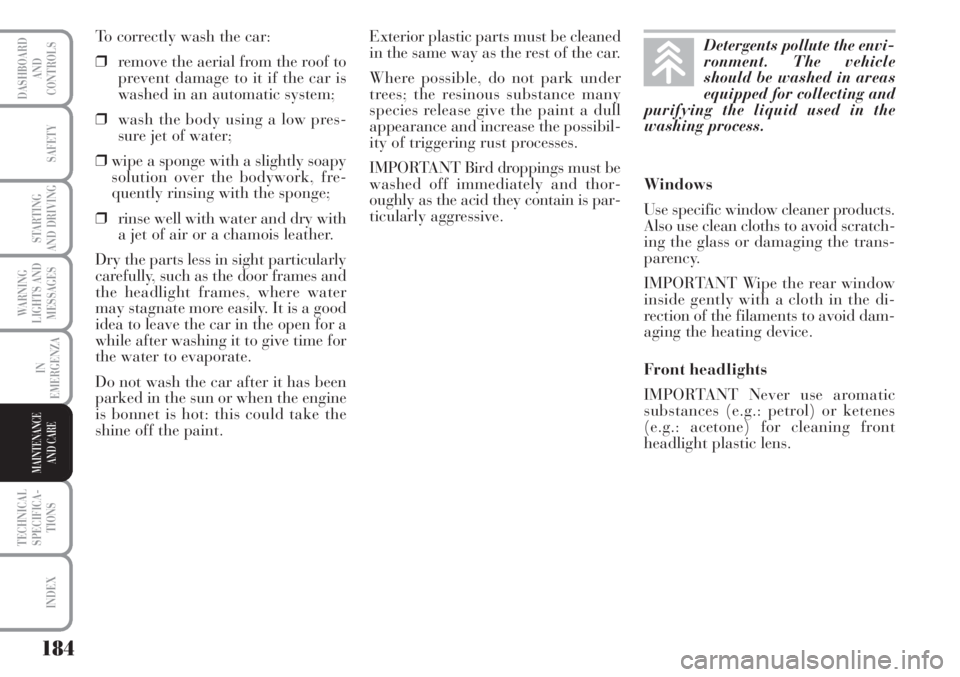
184
WARNING
LIGHTS AND
MESSAGES
TECHNICAL
SPECIFICA-
TIONS
INDEX
DASHBOARD
AND
CONTROLS
SAFETY
STARTING
AND DRIVING
IN
EMERGENZA
MAINTENANCE
AND CARE
To correctly wash the car:
❒remove the aerial from the roof to
prevent damage to it if the car is
washed in an automatic system;
❒wash the body using a low pres-
sure jet of water;
❒wipe a sponge with a slightly soapy
solution over the bodywork, fre-
quently rinsing with the sponge;
❒rinse well with water and dry with
a jet of air or a chamois leather.
Dry the parts less in sight particularly
carefully, such as the door frames and
the headlight frames, where water
may stagnate more easily. It is a good
idea to leave the car in the open for a
while after washing it to give time for
the water to evaporate.
Do not wash the car after it has been
parked in the sun or when the engine
is bonnet is hot: this could take the
shine off the paint.Exterior plastic parts must be cleaned
in the same way as the rest of the car.
Where possible, do not park under
trees; the resinous substance many
species release give the paint a dull
appearance and increase the possibil-
ity of triggering rust processes.
IMPORTANT Bird droppings must be
washed off immediately and thor-
oughly as the acid they contain is par-
ticularly aggressive.Windows
Use specific window cleaner products.
Also use clean cloths to avoid scratch-
ing the glass or damaging the trans-
parency.
IMPORTANT Wipe the rear window
inside gently with a cloth in the di-
rection of the filaments to avoid dam-
aging the heating device.
Front headlights
IMPORTANT Never use aromatic
substances (e.g.: petrol) or ketenes
(e.g.: acetone) for cleaning front
headlight plastic lens.Detergents pollute the envi-
ronment. The vehicle
should be washed in areas
equipped for collecting and
purifying the liquid used in the
washing process.
Page 189 of 218
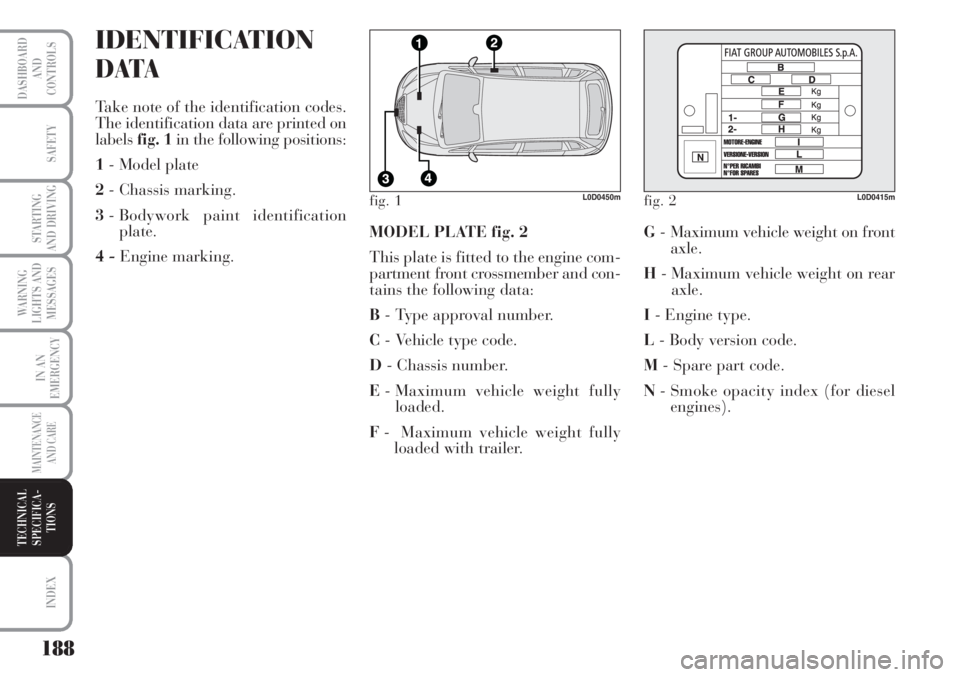
IDENTIFICATION
DATA
Take note of the identification codes.
The identification data are printed on
labelsfig. 1in the following positions:
1- Model plate
2- Chassis marking.
3- Bodywork paint identification
plate.
4 - Engine marking.MODEL PLATE fig. 2
This plate is fitted to the engine com-
partment front crossmember and con-
tains the following data:
B- Type approval number.
C- Vehicle type code.
D- Chassis number.
E- Maximum vehicle weight fully
loaded.
F- Maximum vehicle weight fully
loaded with trailer.G- Maximum vehicle weight on front
axle.
H- Maximum vehicle weight on rear
axle.
I- Engine type.
L- Body version code.
M- Spare part code.
N- Smoke opacity index (for diesel
engines).
fig. 1L0D0450mfig. 2L0D0415m
188
WARNING
LIGHTS AND
MESSAGES
INDEX
DASHBOARD
AND
CONTROLS
SAFETY
STARTING
AND DRIVING
IN AN
EMERGENCY
MAINTENANCE
AND CARE
TECHNICAL
SPECIFICA-
TIONS
Page 194 of 218

BRAKES
Service brakes:
– front
– rear
Parking brake
IMPORTANT Water, ice and salt sprinkled on the roads may deposit on the brake disks reducing braking efficiency the first time the
brakes are applied.
(
▲) Engine version for some versions/markets only 1.4
8V(▲)-1.416V- 1.3 Multijet 70 HP
Self-ventilating discs (257 mm x 22 mm)
Drum (203 mm x 38 mm)
Operated by hand lever, acting on
rear brakes
SUSPENSIONS
Front
Rear
(
▲) Engine version for some versions/markets only 1.4
8V(▲)-1.416V- 1.3 Multijet - 1.6 Multijet
McPherson independent wheels
Semi-independent wheels interconnected by means of torque axle
STEERING SYSTEM
Type
Steering circle
(kerb to kerb) m
(
▲) Engine version for some versions/markets only 1.4
8V(▲)-1.416V- 1.3 Multijet - 1.6 Multijet
Rack and pinion with electric power steering
10,0
1.3 Multijet 90 HP - 1.3 Multijet 95 HP
1.6 Multijet
Self-ventilating discs (284 mm x 22 mm)
1.3 Multijet 90 HP -1.3 Multijet 95 HP: drum
(228 mm x 40 mm)
1.6 Multijet: disc (240 mm x 11 mm)
Operated by hand lever, acting on
rear brakes
193
WARNING
LIGHTS AND
MESSAGES
INDEX
DASHBOARD
AND
CONTROLS
SAFETY
STARTING
AND DRIVING
IN AN
EMERGENCY
MAINTENANCE
AND CARE
TECHNICAL
SPECIFICA-
TIONS
Page 198 of 218
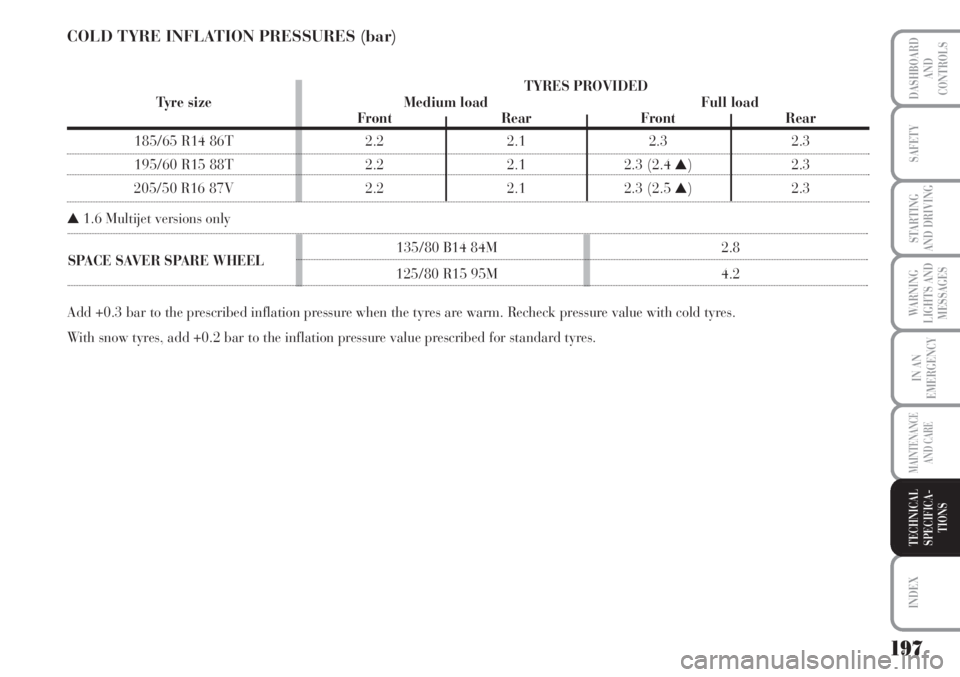
135/80 B14 84M 2.8SPACE SAVER SPARE WHEEL
125/80 R15 95M 4.2
TYRES PROVIDED
Tyre size Medium load Full load
Front Rear Front Rear
Add +0.3 bar to the prescribed inflation pressure when the tyres are warm. Recheck pressure value with cold tyres.
With snow tyres, add +0.2 bar to the inflation pressure value prescribed for standard tyres.
COLD TYRE INFLATION PRESSURES (bar)
185/65 R14 86T 2.2 2.1 2.3 2.3
195/60 R15 88T 2.2 2.1 2.3 (2.4 ▲)2.3
205/50 R16 87V 2.2 2.1 2.3 (2.5 ▲)2.3
▲1.6 Multijet versions only
197
WARNING
LIGHTS AND
MESSAGES
INDEX
DASHBOARD
AND
CONTROLS
SAFETY
STARTING
AND DRIVING
IN AN
EMERGENCY
MAINTENANCE
AND CARE
TECHNICAL
SPECIFICA-
TIONS
Page 201 of 218
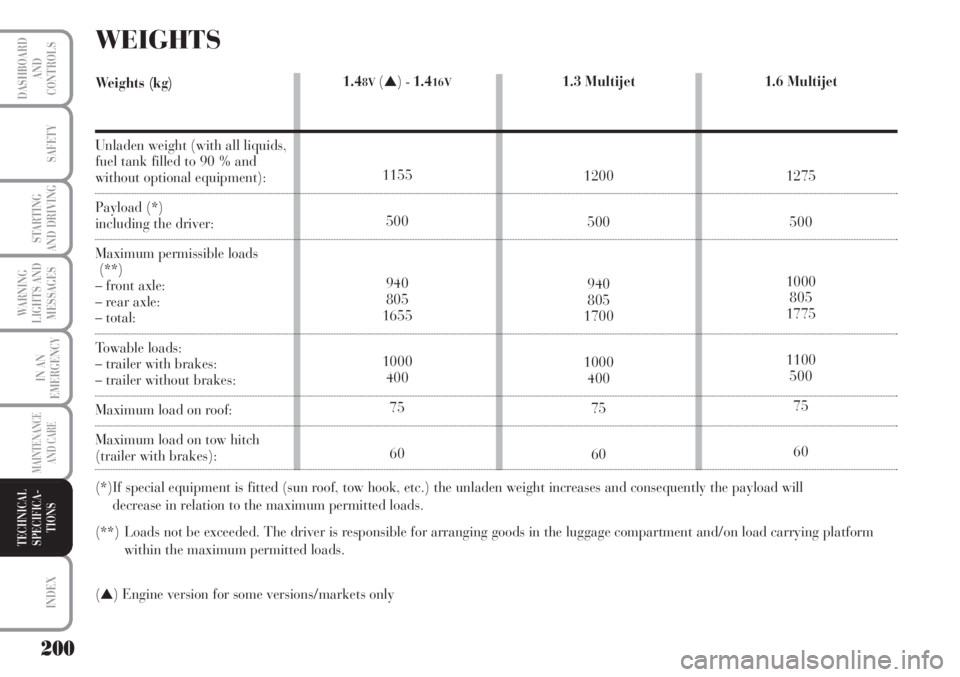
1.48V(▲)-1.416V
1155
500
940
805
1655
1000
400
75
601.3 Multijet
1200
500
940
805
1700
1000
400
75
601.6 Multijet
1275
500
1000
805
1775
1100
500
75
60
WEIGHTS
Weights (kg)
Unladen weight (with all liquids,
fuel tank filled to 90 % and
without optional equipment):
Payload (*)
including the driver:
Maximum permissible loads
(**)
– front axle:
– rear axle:
– total:
Towable loads:
– trailer with brakes:
– trailer without brakes:
Maximum load on roof:
Maximum load on tow hitch
(trailer with brakes):
(*)If special equipment is fitted (sun roof, tow hook, etc.) the unladen weight increases and consequently the payload will
decrease in relation to the maximum permitted loads.
(**) Loads not be exceeded. The driver is responsible for arranging goods in the luggage compartment and/on load carrying platform
within the maximum permitted loads.
(
▲) Engine version for some versions/markets only
200
WARNING
LIGHTS AND
MESSAGES
INDEX
DASHBOARD
AND
CONTROLS
SAFETY
STARTING
AND DRIVING
IN AN
EMERGENCY
MAINTENANCE
AND CARE
TECHNICAL
SPECIFICA-
TIONS
Page 202 of 218
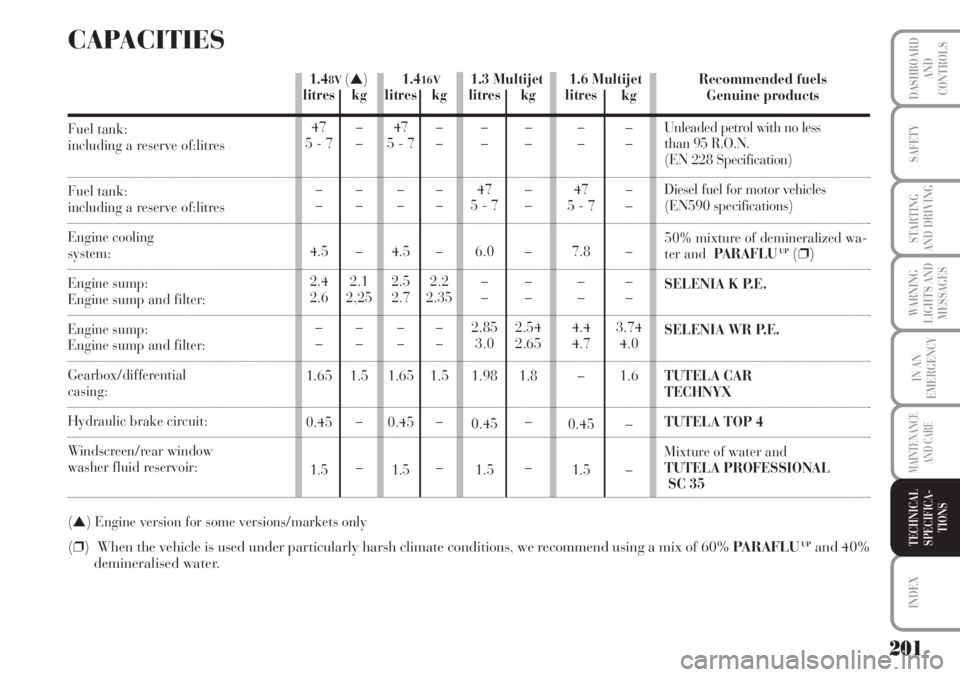
1.6 Multijet 1.416V1.48V(▲)1.3 Multijet
CAPACITIES
Fuel tank:
including a reserve of:litres
Fuel tank: including a reserve of:litres
Engine cooling
system:
Engine sump:
Engine sump and filter:
Engine sump:
Engine sump and filter:
Gearbox/differential
casing:
Hydraulic brake circuit:
Windscreen/rear window
washer fluid reservoir:
(▲) Engine version for some versions/markets only
(❐) When the vehicle is used under particularly harsh climate conditions, we recommend using a mix of 60% PA R A F L UUPand 40%
demineralised water.
kg
–
–
–
–
–
–
–
3.74
4.0
1.6
–
–Recommended fuels
Genuine products
Unleaded petrol with no less
than 95 R.O.N.
(EN 228 Specification)
Diesel fuel for motor vehicles
(EN590 specifications)
50% mixture of demineralized wa-
ter andPARAFLU
UP(❐)
SELENIA K P.E.
SELENIA WR P.E.
TUTELA CAR
TECHNYX
TUTELA TOP 4
Mixture of water and
TUTELA PROFESSIONAL
SC 35 litres
47
5 - 7
–
–
4.5
2.4
2.6
–
–
1.65
0.45
1.5kg
–
–
–
–
–
2.1
2,25
–
–
1.5
–
–litres
47
5 - 7
–
–
4.5
2.5
2.7
–
–
1.65
0.45
1.5kg
–
–
–
–
–
2.2
2.35
–
–
1.5
–
–litres
–
–
47
5 - 7
6.0
–
–
2.85
3.0
1.98
0.45
1.5kg
–
–
–
–
–
–
–
2.54
2.65
1.8
–
–litres
–
–
47
5 - 7
7.8
–
–
4.4
4.7
–
0.45
1.5
201
WARNING
LIGHTS AND
MESSAGES
INDEX
DASHBOARD
AND
CONTROLS
SAFETY
STARTING
AND DRIVING
IN AN
EMERGENCY
MAINTENANCE
AND CARE
TECHNICAL
SPECIFICA-
TIONS
Page 204 of 218
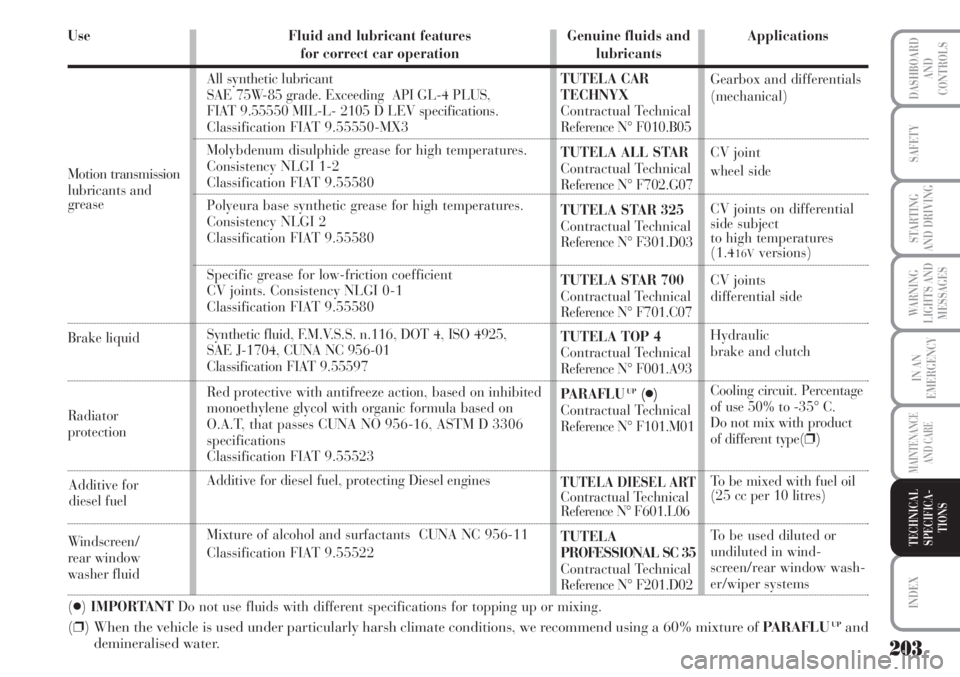
Use
(●)IMPORTANT Do not use fluids with different specifications for topping up or mixing.
(❐) When the vehicle is used under particularly harsh climate conditions, we recommend using a 60% mixture of PARAFLUUPand
demineralised water.
Fluid and lubricant features
for correct car operation
All synthetic lubricant
SAE 75W-85 grade. Exceeding API GL-4 PLUS,
FIAT 9.55550 MIL-L- 2105 D LEV specifications.
Classification FIAT 9.55550-MX3
Molybdenum disulphide grease for high temperatures.
Consistency NLGI 1-2
Classification FIAT 9.55580
Polyeura base synthetic grease for high temperatures.
Consistency NLGI 2
Classification FIAT 9.55580
Specific grease for low-friction coefficient
CV joints. Consistency NLGI 0-1
Classification FIAT 9.55580
Synthetic fluid, F.M.V.S.S. n.116, DOT 4, ISO 4925,
SAE J-1704, CUNA NC 956-01
Classification FIAT 9.55597
Red protective with antifreeze action, based on inhibited
monoethylene glycol with organic formula based on
O.A.T, that passes CUNA NO 956-16, ASTM D 3306
specifications
Classification FIAT 9.55523
Additive for diesel fuel, protecting Diesel engines
Mixture of alcohol and surfactants CUNA NC 956-11
Classification FIAT 9.55522Genuine fluids and
lubricants
TUTELA CAR
TECHNYX
Contractual Technical
Reference N° F010.B05
TUTELA ALL STAR
Contractual Technical
Reference N° F702.G07
TUTELA STAR 325
Contractual Technical
Reference N° F301.D03
TUTELA STAR 700
Contractual Technical
Reference N° F701.C07
TUTELA TOP 4
Contractual Technical
Reference N° F001.A93
PA R A F L U
UP(●)
Contractual Technical
Reference N° F101.M01
TUTELA DIESEL ARTContractual Technical
Reference N° F601.L06
TUTELA
PROFESSIONAL SC 35
Contractual Technical
Reference N° F201.D02Applications
Gearbox and differentials
(mechanical)
CV joint
wheel side
CV joints on differential
side subject
to high temperatures
(1.4
16Vversions)
CV joints
differential side
Hydraulic
brake and clutch
Cooling circuit. Percentage
of use 50% to -35° C.
Do not mix with product
of different type
(❐)
To be mixed with fuel oil
(25 cc per 10 litres)
To be used diluted or
undiluted in wind-
screen/rear window wash-
er/wiper systems Motion transmission
lubricants and
grease
Brake liquid
Radiator
protection
Windscreen/
rear window
washer fluid
203
WARNING
LIGHTS AND
MESSAGES
INDEX
DASHBOARD
AND
CONTROLS
SAFETY
STARTING
AND DRIVING
IN AN
EMERGENCY
MAINTENANCE
AND CARE
TECHNICAL
SPECIFICA-
TIONS
Additive for
diesel fuel